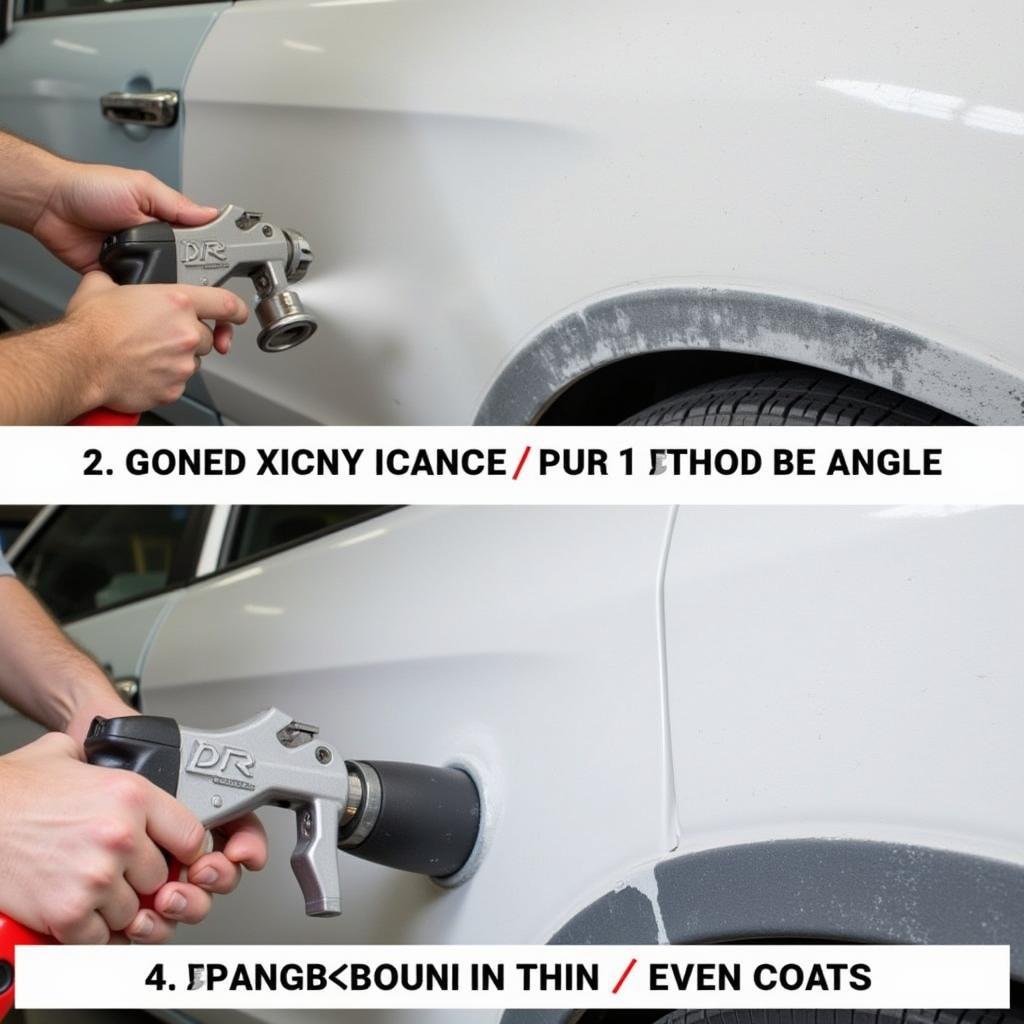Car paint shrinkage is a frustrating issue that can mar the appearance of your vehicle. Whether you’re a seasoned car enthusiast, a professional mechanic, or simply a car owner looking to maintain your vehicle’s aesthetics, understanding How To Fix Car Paint Shrinkage is essential. This guide delves into the causes, prevention, and solutions for this common paint problem.
Understanding Car Paint Shrinkage
Car paint shrinkage occurs when the applied paint film contracts or pulls back, revealing the underlying primer or even bare metal. This can result in unsightly bare spots, uneven texture, and a compromised finish. Several factors contribute to paint shrinkage, including improper surface preparation, incompatible paint layers, environmental conditions, and incorrect application techniques.
Common Causes of Paint Shrinkage
- Poor Surface Preparation: Grease, dirt, wax, or rust on the surface can prevent the paint from adhering properly, leading to shrinkage.
- Incompatible Paint Products: Mixing different paint brands or types without ensuring compatibility can cause chemical reactions that result in shrinkage.
- Environmental Factors: Extreme temperatures, high humidity, or direct sunlight during the painting process can affect the paint’s curing process and contribute to shrinkage.
- Incorrect Application Techniques: Applying excessively thick coats, failing to allow sufficient drying time between coats, or using incorrect spray gun settings can all lead to paint shrinkage.
Fixing Car Paint Shrinkage: A Step-by-Step Guide
Addressing car paint shrinkage requires patience and attention to detail. Here’s a comprehensive guide on how to fix the problem effectively:
- Assess the Damage: Carefully inspect the affected area to determine the extent of the shrinkage.
- Prepare the Surface: Thoroughly clean the area with a wax and grease remover. If rust is present, remove it with a wire brush or sandpaper. Sand the affected area and surrounding paint with progressively finer grit sandpaper to create a smooth, even surface for the new paint to adhere to.
- Apply Primer: If the bare metal is exposed, apply a thin, even coat of automotive primer. Allow the primer to dry completely according to the manufacturer’s instructions.
- Apply Paint: Using the correct paint type for your vehicle, apply several thin, even coats, allowing each coat to dry thoroughly before applying the next.
- Wet Sanding (Optional): If necessary, wet sand the painted area with very fine grit sandpaper to achieve a smooth, flawless finish.
- Apply Clear Coat: Apply several thin, even coats of clear coat to protect the paint and enhance its gloss.
 Applying Car Paint Correctly to Prevent Shrinkage
Applying Car Paint Correctly to Prevent Shrinkage
Preventing Car Paint Shrinkage
Preventing paint shrinkage is always better than having to fix it. Here are some preventative measures:
- Proper Surface Preparation: Ensure the surface is clean, dry, and free of any contaminants before painting.
- Use Compatible Products: Use paint and primer from the same manufacturer or ensure compatibility between different brands.
- Control Environmental Conditions: Paint in a well-ventilated area with a stable temperature and humidity level, away from direct sunlight.
- Correct Application Techniques: Apply thin, even coats and allow sufficient drying time between coats.
What are the signs of paint shrinkage?
You’ll notice the paint pulling back, exposing the primer or bare metal. It often looks like small cracks or a crinkled texture.
Can I fix minor paint shrinkage myself?
Yes, minor shrinkage can often be fixed with careful sanding and repainting.
Expert Advice on Car Paint Shrinkage
“Proper surface preparation is paramount. It’s the foundation of a successful paint job and the key to preventing shrinkage,” says John Miller, Automotive Paint Specialist at ColorMatch Pro.
“Always test the compatibility of different paint products on a small, inconspicuous area before applying them to the entire panel,” advises Sarah Chen, Senior Technician at Auto Refinishing Solutions.
Conclusion
Fixing car paint shrinkage can be achieved with the right approach and attention to detail. By understanding the causes, following the correct repair steps, and implementing preventative measures, you can maintain your car’s flawless finish. If you require professional assistance or advice, connect with us at AutoTipPro. Contact us at +1 (641) 206-8880 or visit our office at 500 N St Mary’s St, San Antonio, TX 78205, United States. We are here to help you keep your car looking its best!
 Finished Car Paint Repair After Addressing Shrinkage
Finished Car Paint Repair After Addressing Shrinkage
FAQ
- What causes car paint to shrink? Improper surface preparation, incompatible paints, environmental factors, and incorrect application techniques.
- How can I prevent car paint shrinkage? Ensure a clean surface, use compatible products, control the environment during painting, and use proper application techniques.
- What tools do I need to fix car paint shrinkage? Sandpaper, primer, paint, clear coat, spray gun (optional), and cleaning supplies.
- Can I use a heat gun to fix paint shrinkage? No, a heat gun can worsen the problem.
- How long does it take for car paint to cure completely? This depends on the paint type and environmental conditions, but it usually takes several days to a few weeks.
- Should I wet sand after painting? Wet sanding is optional but can help achieve a smoother finish.
- When should I seek professional help for car paint shrinkage? If the damage is extensive or you are uncomfortable with the repair process.






Leave a Reply